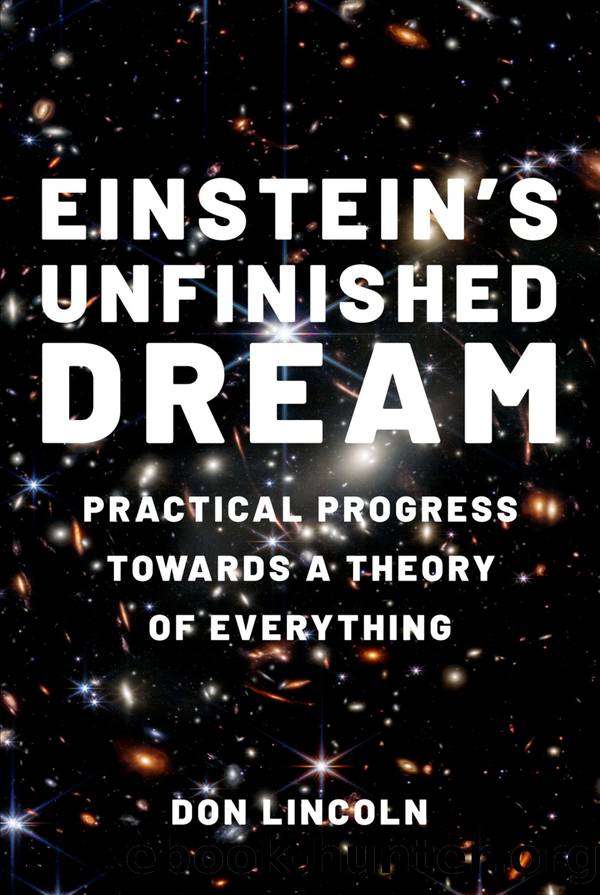Einstein's Unfinished Dream by Lincoln Don;

Author:Lincoln, Don;
Language: eng
Format: epub
Publisher: Oxford University Press, Incorporated
Published: 2023-05-15T00:00:00+00:00
Alternatives to Dark Matter
Given the long and unsuccessful history in searching for dark matter, we should consider some of the other alternatives. As I described in the section discussing Vera Rubin, it is possible that dark matter doesnât actually exist. Instead, the other big possibility is that we donât fully understand the laws of motion or how gravity works.
In this section, Iâll talk about those two possibilities. While they seem to be different, they are more intertwined than appears at first blush. Hopefully it will all be clear.
The first attempt to come up with a nonâdark matter explanation for the glut of astronomical mysteries that became apparent in the 1970s was made by Israeli physicist Mordehai Milgrom in 1982. He came up with an explanation that approached the problem by assuming that Newtonâs second law of motion was incomplete.
Newtonâs second law states that the acceleration an object experiences is directly proportional to the force applied to it. (If you ever took a physics class and remember any of it, this is the equation F = ma.) Increase a force by 50%, and the acceleration will go up by the same amount.
Milgrom decided to use Rubinâs measurements of the rotation rates of galaxies to motivate his thinking. As a reminder, she showed that at large distances from the galactic center that stars orbited at roughly constant speed, while Newtonâs equations predicted that the orbital speed would get slower and slower as one looks at stars far from the center. What Milgrom wanted to do was to generate equations that would predict a stellar speed that was constant, independent of radius (at large orbital radii), while keeping the behavior predicted by Newton at small orbital radii.
In the case of galactic rotation, the force (and consequently acceleration) is larger near the center and weaker at the periphery. So he proposed that for large accelerations, Newtonâs law still held. However, for smaller accelerations, he suggested a new equation.
The acceleration due to gravity depends on one over the radius squared (1/r2), while the acceleration required to move in a circle depends on one over the radius (1/r). Since the two accelerations are on opposite sides of the equal sign (of the motion equals gravity equation), and he wanted to get rid of any radial dependence, he simply modified Newtonâs second law from being the familiar version, which says force is proportional to acceleration (F â a), to a new equation that says that force is proportional to acceleration squared (F â a2).
This choice put a one over radius squared on both sides of the equation, which then cancelled out. The result was that he got the result he wanted: At large distances from the center of galaxies, stars moved with constant velocity.
Of course, he got that result because he engineered the equations to get the desired outcome. Thatâs not necessarily a bad thing; after all, looking at data and devising equations that agree with it is a time-honored technique for trying to understand the natural world.
Download
This site does not store any files on its server. We only index and link to content provided by other sites. Please contact the content providers to delete copyright contents if any and email us, we'll remove relevant links or contents immediately.
| Atomic & Nuclear Physics | Particle Physics |
The Complete Stick Figure Physics Tutorials by Allen Sarah(7135)
Secrets of Antigravity Propulsion: Tesla, UFOs, and Classified Aerospace Technology by Ph.D. Paul A. Laviolette(4974)
Thing Explainer by Randall Munroe(3782)
The River of Consciousness by Oliver Sacks(3412)
The Order of Time by Carlo Rovelli(3072)
How To by Randall Munroe(2911)
I Live in the Future & Here's How It Works by Nick Bilton(2839)
A Brief History of Time by Stephen Hawking(2819)
What If?: Serious Scientific Answers to Absurd Hypothetical Questions by Randall Munroe(2542)
The Great Unknown by Marcus du Sautoy(2532)
Midnight in Chernobyl by Adam Higginbotham(2384)
Blockchain: Ultimate Step By Step Guide To Understanding Blockchain Technology, Bitcoin Creation, and the future of Money (Novice to Expert) by Keizer Söze(2379)
Networks: An Introduction by Newman Mark(2264)
The Meaning of it All by Richard Feynman(2213)
Easy Electronics by Charles Platt(2204)
The Tao of Physics by Fritjof Capra(2162)
Midnight in Chernobyl: The Untold Story of the World's Greatest Nuclear Disaster by Adam Higginbotham(2074)
When by Daniel H Pink(2020)
Introducing Relativity by Bruce Bassett(2015)
